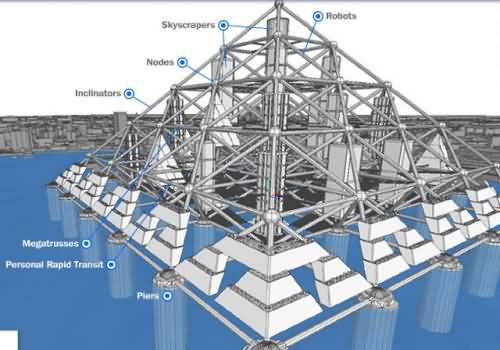Japan Vision: Seven huge projects for the future
Famous Japanese architecture firm Shimizu recently released six bold architectural ideas, which I think will not be korean jokes in the future:
1. Luna Ring
To meet the energy demand, a large solar panel could be set up on the moon's equator, and the electricity converted from the collected solar energy would be transmitted to a nearby power plant, which would then convert it into microwaves and lasers, and then transmit these energy beams to a receiving station on Earth, which would then convert them into electricity
The building materials for the power plant on the Moon would be local: cement, bricks and fiberglass made from lunar rocks and soil; Water would be obtained through a chemical reaction between the moon's soil and helium. #steen: It's sad that the moon is so close to the Earth
As for the installation of the generator, parts will be sent from Earth to space and assembled before landing on the moon. The vast majority of these tasks will be done by robots, and a crew of astronauts will be sent to the moon to oversee more robot work
2. Ocean City (Green Float)
This large structure, which resembles a lotus leaf floating on the water, is actually a future city floating on the equatorial Pacific Ocean, chosen because it is less affected by tropical storms
Each floating island has a central tower 1,000 meters high, the ground floor is the various operating equipment of the industrial area, the upper floor is the residential area. The entire tower will house around 4,000 residents, and the island is made up of forests, green Spaces, waterways and water storage areas. Of course, there are also agricultural growing areas and aquaculture areas, and in the future this will be a completely self-sufficient city
#steen: Dubai also has a concept pyramid. Eight great projects
The base of the ocean city is made up of 7,000 tons, 20 meters wide, 50 meters deep underwater small base connected by hexagonal pipes, the main building material of these bases can be extracted from seawater, every 770 tons of seawater can be extracted to extract 1 ton of magnesium
3. Mega-City Pyramid
The Pyramid city is a self-contained, one-million-person city built from lightweight materials like carbon and fiberglass, a pyramid pattern that allows sunlight to reach every node
The inner nodes of the pyramid can be used for living, office, research, shopping malls and entertainment centers, and the diameter of the connecting rod between each node is 10-16 meters, in which the city's electricity, communication system, elevator, water supply and even transportation rail is loaded
4. Space Hotel
With the continuous development of space tourism in the future, the construction of space hotels is more promising. Shimizu's space hotel will operate in low Earth orbit, an area where microgravity will be possible. The entire hotel is powered entirely by solar energy, where people can play sports, eat and watch the earth and stars more
5. Lunar Bases
Well, the moon again. In order to facilitate future hikers in outer space, it is necessary to build a base camp similar to Everest on the moon. The base will have a modular design, all made up of hexagonal detachable modules, which will be assembled by remotely controlled robots
6. Urban Geo-Grid Plan
Back on Earth, Shimizu's grid design aims to reduce congestion in the metropolis and improve the overall efficiency of the city. For the congested Tokyo, a grid city composed of underground networks, grid points and grid stations is planned to be built in the area between it and the Boso Peninsula. Most of the infrastructure will be deployed underground, such as transportation. The grid points will deploy grocery stores, exhibition halls, public bathrooms, etc.; The grid station will set up large office buildings, hotels, shopping malls, train stations and more
7. Desert Aqua-Net Plan
The aim is to make inhospitable deserts habitable by building a network of artificial lakes and canals
Several giant artificial lakes up to 30 kilometers in diameter and 20-30 meters deep will be built here. The lakes are connected by an artificial canal 50 meters wide and 10 meters deep. Artificial islands will be built in artificial lakes, and as for water sources, more seawater will be used
I think there are some problems with this. I am afraid that the desert environment is difficult for robots to work
